
Transcription
Curr PsycholDOI 10.1007/s12144-017-9684-7Psychological Dimensions of Drone WarfareAlaa Hijazi 1 & Christopher J. Ferguson 2 & Harold Hall 3 & Mark Hovee 4 &F. Richard Ferraro 5 & Sherrie Wilcox 6# Springer Science Business Media, LLC 2017Abstract The use of weaponized drones or Bunmanned aerialvehicles (UAVs) has become increasingly widespread andcontroversial over the past few decades. The current paperreviews the state of the research regarding the potential psychosocial impact of weaponized drones on operators and target populations and communities. It is concluded that researchregarding the impact of drones in the psychological literatureremains limited and most discussion of drones’ impact hastaken place in the public policy and legal/ethical spheres, oftenby entities invested in condoning or condemning the use ofdrones. The limited available data addresses potential newchallenges to the well-being of drone operators, factorsinfluencing decision making regarding the use of drones,and the impact on target communities. The current paper neither condones nor condemns the use of drones, but is advanced as a state of the research and a call for additionalobjective and empirical analysis on this relatively new formof warfare.Division 48 Presidential Task Force, 2013–2014: Research Agenda forthe Psychology of Weaponized Unmanned Aerial Vehicles (Drones)* Christopher J. FergusonCJFerguson1111@aol.com1American University of Beirut, Beirut, Lebanon2Department of Psychology, Stetson University, 421 N. WoodlandBlvd, DeLand, FL 32729, USA3Pacific Institute Study Conflict & Aggression, Kamuela, HI, USA4George Fox University, Newberg, Oregon, USA5University of North Dakota, Grand Forks, North Dakota, USA6Uniformed Services University of the Health Sciences,Bethesda, MD, USAKeywords Drones . Warfare . Unarmed aerial vehicles .Operators . Target communitiesIntroductionDrone warfare refers to the use of weaponized unmannedaerial vehicles (UAV, henceforth simply Bdrones ) in militaryencounters. UAVs are used for multiple purposes, civilian andmilitary, weaponized and non-weaponized. The discussion inthis paper refers only to weaponized UAVs. The military useof drones has been attracting increasing attention and controversy due to their use by the United States military in a varietyof military actions collectively referred to as the BWar onTerror . However, drones are in use across a number of industrialized and non-industrialized nations and their proliferationis likely to increase. The use of drones in warfare is perceivedby the military to have several advantages. Being unmanned,drones involve no direct risk to pilots compared to mannedaerial vehicles. Drones also have operational advantages suchas remaining in-theater for long periods of time without requiring refueling or inducing pilot fatigue. Also, decisionsregarding firing can involve multiple parties in the chain ofcommand. However, the use of drones has also raised questions regarding their potential impact on both the operatorsand the targeted communities.The Task ForceThis paper is based on the work of a taskforce assembled inresponse to an open call by then-president of Division 48,Rachel MacNair. Although an ethical debate on drone usemay be worthy, it was not the stated purpose of the task forceto comment on the ethics or politics of drone warfare. Rather,
Curr Psycholthe purpose of this paper is to synthesize the available dataregarding the psychological dimensions of drones and to identify gaps in the literature in need of new empirical information.Task force members were specifically recruited to reflect arange of opinions regarding the ethics of drones and camefrom a variety of backgrounds, clinical and experimental,some with military expertise, most without. None of the taskforce members have a conflict of interest regarding dronewarfare and none have taken prior public stances about it.Our conclusions should not be interpreted either as supportiveor condemnatory of drone use.Sources of DataEmpirical psychological research on drone warfare is extremely sparse. Our task force therefore had to consider avariety of data sources including: research in sociology andpolitical science; psychological research regarding issues pertinent to drones; post-traumatic stress more generally; researchreports from the military, policy related groups, and nongovernmental organizations; and media sources, such as interviews with relevant parties. Further, we solicited input fromthe APA’s Division 19, as well as from a military psychologistwho requested anonymity. Given the political debates ondrones, we recognize that many writings about them seek tosupport particular policy agendas and that many sources ofinformation are classified.Question Area 1: the Impact on Operatorsof the SystemsOverview of Empirical Findings There is minimal empiricalor theoretical research about the psychological impact ofdrone warfare on operators. Teams from the United StatesAir Force School of Aerospace Medicine released severalstudies investigating the mental health of various categoriesof Air Force soldiers, including drone operators. Two studiesinvestigating burnout among remotely piloted aircraft (RPA)operators found that nearly half reported being stressed toextremely stressed (Chappelle et al. 2011b), 20% reportedfeeling emotionally exhausted, a key dimension of job burnout, and 11%–14% had high scores on the cynicism facet ofburnout (Chappelle et al. 2011b; Chapelle et al. 2014b). Theserates are higher than in noncombatant airmen (Chappelle et al.2011b). Rates of clinically significant emotional distressamong RPA operators were found to be around 20%(Chappelle et al. 2012) and approximately 4–5% of RPA operators in two studies endorsed moderate to severe PTSDsymptoms that would meet criteria for diagnosis (Chappelleet al. 2012; Chapelle et al. 2014a). These figures are higherthan the 1% reported in electronic medical record of droneoperators (Chapelle et al. 2014a) and higher than the corresponding rates for noncombatant airmen (11% and 2%;Chappelle et al. 2012), but on the lower end of the 4–18%for combat soldiers returning from deployment (Chapelleet al. 2014a). The odds of endorsing high burnout or PTSDsymptoms were found to be higher among those who workedlonger hours and those who have been working as drone operators for more than two years (Chapelle et al. 2014a; b).Rates of mental health disorders in RPA operators were similar to rates in Air Force pilots in the Operation Iraqi Freedomand Operation Enduring Freedom wars, with about 1 in 12drone pilots receiving their first mental health diagnosis oftheir military career. However, these rates were lower thanthose of the Air Force overall (Otto and Webber 2013). Twostudies indicated that combat related stressors such as constantexposure to images of death and destruction and killing civilians or friendly ground forces were not rated as primary causesof distress. Rather, most operators cited demands such aslong hours, frequently rotating shift work, fatigue and boredom from sustained vigilance to large amounts of audiovisual data, human-machine interface factors, difficulty ofjuggling work and family, geographical location of the military bases, being understaffed, and concerns about career(Chappelle et al. 2011b, 2012).Psychological Dimensions of Being a Drone Operator Thebelow section will highlight the need for further research toexplore how various psychological dimensions of the droneoperator experience may be different from other soldiers’ experience. The section also addresses the special therapeuticneeds of drone operators. The question of what is mostuseful and needed with this specific population has rarelybeen assessed empirically, and current conditions indicate thisis a pressing need.The Psychological Effect of Killing Unlike regular soldierswho partake in a range of combat duties that may involvethreat to self or violence to others, drone operators are safefrom danger to self, and by definition of the job, involved intargeted killings. There is increased interest in understandingthe psychological response to engaging in violence towardsothers. For example, MacNair (2002) coined the termPerpetration Induced Traumatic Stress to describe PTSDsymptoms in response to enacting violence. She found higherPTSD scores in American Vietnam War veterans who hadkilled someone than in those who had not, even when killingwas in a sanctioned military context. Similarly, Maguen et al.(2009, 2010) found that after accounting for general combatexperience, killing combatants and noncombatants was associated with PTSD, dissociation, functional impairment, andviolent behavior in American Vietnam War veterans. Greaterfrequency of killing was associated with twice the odds ofsuicidal ideation, compared to no or low killing, even after
Curr Psycholcontrolling for combat exposure, PTSD symptoms, and depression (Maguen et al. 2011). Given that drone pilots engagein killing and witness the impact of their confirmed killing onscreen, it is likely they may experience negative psychologicaloutcomes in response. Further research is needed to explorethese effects.Chapelle and McDonald (2011) proposed that unlike thetypical PTSD of soldiers in response to clear external dangers,RPA operators may experience Bexistential conflict , guilt,and remorse over their perceptions of themselves as aerialsnipers, witnessing collateral damage following their strikes,and being psychologically attached to the combatants. Moralinjury is a relevant new concept garnering increased attention.It is defined by Litz et al. (2009) as "lasting psychological,biological, spiritual, behavioral, and social impact of perpetrating, failing to prevent, or bearing witness to acts that transgress deeply held moral beliefs and expectations . Accordingto Stein et al. (2012), combat acts that involved moral injury toself were significantly associated with various dimensions ofguilt and with severity of re-experiencing symptoms compared to other combat acts. Among combat veterans, moralinjury is also associated with depression, anxiety, guilt, shame,loss of self-worth, existential and spiritual issues such as lossof meaning, spiritual conflict, and questioning one’s morality(Drescher et al. 2011; Vargas et al. 2013). Some experimentalresearch indicates that greater social invalidation of a killingact predicts greater feelings of distress (Webber et al. 2013).We propose that with popular and legal controversy over themorality of drone warfare, high published rates of civiliandeaths, operators’ ability to visually witness the impact of theirstrikes, and the lack of imminent danger to self as justificationfor one’s actions, drone operators may be at elevated risk ofexperiencing moral injury. A military psychologist treatingdrone operators acknowledged that many do experience moralinjury (Wood 2013).Yet, drone warfare is also perceived to include many advantages such as saving American troops’ lives and beinghighly precise and efficient in killing militants (Byman2013). Accordingly, participating in a potentially more popular and advantageous war form might be associated with lesssocial invalidation, more sense of purpose, and potentially lessrisk of moral injury or distress. It would be useful for futureresearch to contrast the experiences of distress and moral injury among drone operators vs. soldiers in conventionalcombat.In the case of other combat veterans who have engaged inkilling, it has been suggested that the techniques of ProlongedExposure (flooding) and expressive writing may be ineffective (MacNair 2002), and that Time Perspective Therapy maybe helpful (Zimbardo et al. 2012). Additionally, traditions ofatonement, bearing witness, and therapeutic stories have beenwidely suggested as possibilities. However, the empiricalstudies that take killing as the etiological stressor for PTSDsymptomatology are not yet adequate to ascertain how to fillthe needs of combat veterans in general, much less the particular needs of drone operators.At present, there is little research examining differences inemotional reaction between pilots of UAVs and those who arein manned vehicles in combat theaters. Given that pilots ofmanned vehicles place themselves at direct risk of harm, thereare sound theoretical reasons to believe that the emotionalexperience will differ in some respects as compared todrone/UAV operators who do not experience direct risk.However, direct analyses of these differences in emotionalexperience remain lacking. The best evidence to date comesfrom a 2013 study from the Armed Forces Health SurveillanceCenter (Otto and Webber 2013) which suggested that dronepilots experienced mental health symptoms at roughly equallevels as manned pilots, though potentially for different reasons such as high time-on-task.It is also important to note that contextual issues matter inthe experiencing of drone pilots. For instance, as strike decision policies change in ways that increase or reduce proportions of civilian casualties, the emotional experiencing ofdrone pilots is likely to change, particularly given the degreethat trauma may be related to civilian casualties. Workingconditions, such as long hours, reduced leave, the compartmentalization of shifting from warfighting to civilian life on adaily basis, and the pressures of particularly theaters such asIraq have also been linked to experiences of stress and anxietyamong drone operators (Ouma et al. 2011). Thus, theexperiencing of drone operators may not be uniform butmay be contextualized under specific training, working andtheater conditions.It is also important to distinguish stress created from theworking conditions of drone operation as opposed to combattrauma. Much of the reviews noted earlier suggest that hightime on task, boredom, pressure, reduced leave time and lowrecognition have all contributed to relatively high stressamong drone operators. However, this stress is distinct fromcombat trauma. Some review speculate that needing to watcha battlefield continuously over hours, witnessing the consequence of a strike, could contribute to stress and trauma, abovethat experienced by manned vehicle pilots. Further, it is notunreasonable to hypothesize that stress will be greater in thecontext of civilian casualties, or in situations in which theparameters for carrying out a strike were more ambiguous.One potential issue also may come in the screening andrecruitment of drone which historically had not differedfrom manned vehicle pilots (Chappelle et al. 2011a).However, training failure has been higher among drone recruits. Characteristics related to success in drone piloting,such as rapid processing of multiple visual and auditorysensory experiences and self-reliance may call for the needfor different recruitment and screening procedures fordrone pilots.
Curr PsycholEffects of Time and Space Compression Gregory (2011)described the paradox of how drone operators are thousandsof miles away from the combat theater, yet inches away fromthe screen, which creates a compression of time and space.Such compression can pose psychosocial challenges for droneoperators different from those deployed to traditional combattheaters.Whiplash of Being a Civilian and a Combatant Drone operators work in an immersive environment with high-techequipment and multifaceted systems. The rooms are typicallycool and dark to keep electronics safe instead of keeping operators comfortable. At the end of the workday, operatorsleave their confined, high tempo, but occasionally monotonous work environment to return to their domestic roles athome. Operators are prone to extreme boredom due to numerous hours spent viewing primarily innocuous terrain(Cummings et al. 2012; Hancock and Krueger 2010). In addition to monotony and sporadic action, there are difficultiesassociated with rapid psychological switches or Bwhiplash between war fighter and civilian roles (Associated Press2008; Fitzsimmons and Sangha 2010; Ortega 2012;McCloskey 2009). Ortega (2012) discusses how traditionaltroops deployed and returned on ships or planes and thereforehad a buffer between combat and return. This transitory period allowed them the time and space to decompress, processtheir experiences, and reorient themselves for reintegration tocivilian life. Drone operators lack this separation between thecombat and civilian worlds, which can force them to makeradical context shifts that can increase stress (Fitzsimmonsand Sangha 2010; Royakkers and Van Est 2010; Wilcoxand Rank 2013). The transition can become more complicated by being unable to discuss details of the workday withfamily and friends due to security restrictions (Fitzsimmonsand Sangha 2010; Lindlaw, 2008; McCloskey 2009) alongwith a probable desire by family and friends not to hear details of killing people. The benefits of disclosing trauma havelong been known and can improve both physical and mentalfunctioning (Pennebaker 1999). Moreover, operators oftenreport difficulty balancing their fighter role with family andpersonal relationships (Chappelle et al. 2012, 2011a) whichhas been noted to cause family and marital discord(McCloskey 2009). At the same time, separation from homecan be a major stressor for conventional combat soldiers, andbeing able to return daily to the comfort of home and familymay buffer the impact of combat stress in drone operators.Future research may seek to understand how this paradox ofbeing close to the comfort of home, which may offer a protective factor, interplays with the strain of rapid shifting between civilian and combatant roles in influencing operatormental health.Literature on National Guard members (NGM) providesinsight on rapid transitions from war-fighter to civilian.Because of their established civilian life, the rapid civilianmilitary-civilian transition is more difficult for NGM(Wilcox et al. 2015). The post-deployment period is criticalfor readjusting to community and family life. Mental healthchallenges associated with combat and deployment can impede successful family reintegration. NGM and Reservistsexperience more psychological problems than active duty military personnel, and the prevalence of emotional distress increases during the first 180 days post-deployment. Despiteexperiencing psychological difficulties, because NGM are often dispersed throughout their states of residence, they havereduced peer support, and have less access to and are lesslikely to seek treatment (Wilcox et al. 2015).Similar to reduced peer support seen in NGM, operatorsmay miss peer support that comes with conventional combatunits that deploy, fight, and return together. This form of warprovides soldiers with shared experiences that help forge ahigh degree of unit cohesion which can help reduce stressfrom traumatic events. Yet, this may be lacking in drone operation units with commuter operators whose civilian familyand friends fight for their attention. Moreover, off-duty socializing with colleagues is inadequate (Fitzsimmons and Sangha2010), which might be a major detriment to mental wellbeingbecause social immersion in settings where others have similar traumatic experiences and are willing to discuss them improves coping with combat related stress (Fitzsimmons andSangha 2010; Flora 1985).Connection with Targets Interviews with drone pilots andpsychologists (McCloskey 2009; Miller 2012; Schogol2012; Wood 2013) indicate that unlike regular combat pilots,drone pilots may be required to monitor a particular destination on screen for days and weeks. They learn about thecommunity’s pattern of life, observe targets’ daily interactionswith their families and children, and then are subsequentlyordered to strike (Schogol 2012). Prolonged contact and personal connection with a target’s life may represent a noveldimension of combat stress that calls for further inquiry.Operators may exist in a psychologically dissonant statewhere there is disconnection and removal from the battleground but simultaneous feelings of proximity and intimateconnection with targets’ lives. Similarly, drone pilots witnessthe aftermath of a strike on their screens (Wall and Monahan2011) which may heighten the adverse impact of exposure totraumatic stimuli.Connection with Troops Another aspect of drones related totime and space compression is the paradox of operators beingremoved from ground troops but connected to them throughtheir screens. Operators often feel connected to ground troops,can observe the live flow of combat, and may feel distressedwhen fellow soldiers are threatened but they are safely remote(Drew 2010; McCloskey 2009; Ortega 2012). Therefore, the
Curr Psycholpsychological proximity of operators to ground soldiers andits potential effects on feelings of guilt, helplessness, or decisions to strike is important aspect of drone warfare that needsfurther exploration.Impact of Being Out of Danger What is the impact of beingout of danger while killing others, and how does it differ fromcombat soldiers who are in danger themselves? There is littledirect empirical research on this question. However, aggression research suggests that anonymity can play a role in aggression. The interview conducted by the co-chair of the taskforce with an Air Force psychologist (Anonymous, personalcommunication, September 12, 2013) indicated that the military recognizes the threat of acting out of anonymity and beingout of danger as an issue and actively counsels operators totake their responsibilities with the greatest seriousness. Giventhat decisions to fire typically come through a chain of command, the issue may be less about the individual actions ofpilots and more of whether political decisions to use dronesmay be more likely, given that the risk to operators is minimal.As discussed later under bureaucracy in decision making, psychological concepts related to diffusion of responsibility(Mynatt and Sherman 1975; Wallach et al. 1964) or compliance within a hierarchy could also influence drone operatorswho do not, themselves, make the decision to fire.One Government Accountability Office (2014) report suggests drone operators are commonly given fewer opportunitiesfor advancement or medals, given the perception that they arenot equivalent to traditional combat pilots. To the extent thatstress is not balanced with recognition or accolades, this mayincrease the likelihood of burnout or PTSD in operators.Having the sense of inflicting danger on others while notbeing in danger oneself could have psychological ramifications on operators that are not yet well understood. Theseissues may combine to produce situations of compliance atthe moment of combat, yet potentially produce guilt at a latertime when the operators have Btime to think outside of thechain of command.Video Games Do commercial video games, particularlywith action or violent content contribute either to facilityin drone use or desensitization to their use in combat? Inresponse to a question about the role of video games inpilots’ duties, an Air Force psychologist stated that themilitary does not use video games to train drone pilotsnor were video games used to desensitize military personnel. The psychologist did state that simulators are used intraining, but that, overall, the military did not wish toequate drone piloting with games and avoided games forthat purpose. Further, prior research evidence has beenunable to connect playing violent video games to sociallyrelevant aggression or violence (Ferguson 2015).Question Area 2: Decision MakingDecisions to use drone weapons take place in the context ofboth short-term and long-term risks and benefits. As the collective violence and punishment literature in the behavioralsciences makes clear, persons and groups who perceive themselves to be victimized often eventually seek revenge in director indirect ways (see reviews in Hall and Whitaker 1999; Halland Pritchard 2002). Therefore, one issue for U.S.policymakers and government leaders to consider concernsretaliatory capacity and motivation to counterattack. We recommended research directed at the gap between establishedpsychological findings regarding collective violence and punishment and drone warfare.The behavioral science literature regarding violence andrisk analysis provides terminology and models relevant todrone-related situations. All forms of threatened, attempted,or consummated fatal violence can be conceptualized as aninteraction of intentional instigator behaviors acting on a target in a particular context (Hall and Ebert 2002). Several hundred violence-related investigations and reviews have beenconducted during the last half century (e.g. Hall andWhitaker 1999; Hall and Pritchard 2002). Findings suggesttwo basic types of human violence: emotionally-charged,disorganized, impulsive violence; and highly controlled,focused, organized violence. Controlled collective violence involves a high degree of goal formulation, highclarity of thought, low expression of emotion, rapid habituation, organized execution of plans, focused awareness,less likelihood of displacement to victims other than theprimary target, flexible changes in principle, a stated goalof destruction and/or exploitation, and the violence itselffollowed by likely attempts to hide, avoid and conceal.Violence by drone operators and crews closely fits the controlled type of violence, as opposed to impulsive, disorganized violence characterized by high emotion. As such,findings from the literature on controlled violence can beused to formulate research directions for drones.From this literature, the strongest associations with violence are the perpetrator’s history, opportunity and availabilityfactors that make violence possible or expand the degree oflethality, and triggers to aggress. The Bhistory, opportunity,and triggers (HOT) factors can provide a decision modelfor predicting drone-related events with human operators.This places drone-related findings within an empirical modelagain capable of producing testable hypotheses. The researchliterature shows that weapon selection, as an opportunity variable, accounts for only a small contribution to violence, generally less than 5% of the variance (Hall and Ebert 2002).Availability of weapons does not determine whether violencewill occur; it makes it possible. A well-established history ofviolence is the best single predictor of future violence. Forcollective violence, the history of the parties needs to be
Curr Psycholscrutinized. Primary triggers for collective violence are directives from superiors which in the case of drones are ordersfrom above and preset computer programs.Within the context of these factors, a sequence of binarychoices is made by the drone crew from the beginning to theend of the mission. Successful violence, at least that associatedwith external acknowledgment is frequently followed by selfreinforcing thoughts, feelings and behaviors, at least in theinitial unfolding (Hall and Whitaker 1999). The negative features of violence seem to be associated with stress responses tointertwining physical, psychological, and socialpsychological stressors, leading to disorders such as PTSD,discussed in detail earlier.Bureaucratic Decision Making Findings related to decisionmaking were sparse because detailed information on bureaucracy for weaponized drones is classified. A rough outline ispossible, however, from non-classified studies, media announcements, and information pertaining to the military’s bureaucracy. The term Bbureaucratic decision-making refers towhat, how, and by whom decisions are made within andoutside an organization. The flow of information within adrone bureaucracy includes decisions to deploy, track, coordinate and return drones and to monitor their effect.One issue in understanding decision making concerns compliance with authority. Blass (1999) performed a metaanalysis on experiments on obedience to authority such asMilgram’s (1974) and consistently found that 61–66% of participants were willing to inflict fatal voltages in electroshockstudies in response to requests from authority. Although thegeneralizability of these experimental results to trained military personnel can be debated, it seems reasonable to suggestcompliance with authority is a significant factor in thedecision-making process.The drone literature reveals two primary types of U.S. bureaucracies regarding weaponized drones. In both, thePresident is ultimately responsible for whether and howdrones are used. The first type usually, but not always, involves regions of conflict, primarily Iraq and Afghanistan.The top drone purchasing agencies are the military services,with the Army alone accounting for over 90% (Deltek 2012).According to a detailed field manual, drone activities involvetraining, dissemination of equipment and drone assembly kits,usage and control of drone-related information, the duties ofkey personnel apart from the drone crews, coordination withjoint aerial and artillery systems, dynamic re-tasking duringmissions, execution of the Bkill box in an operation, a primary focus on precision hits, and coordination with supportingunits (see Army Unmanned Aircraft System Operations, FMI3–04.155 applicable to the USA, USAF, USMC, USCG,USN, and National Guard units). Military personnel are expected to know and have copies of this manual covering bothsurveillance and weaponized drones.Bureaucratic decisions for this first type are affected bypersonality, and research suggests similarities in personalityand cognitive styles among U.S. military leadership. Moraski(2002) found that 95% of senior military leaders are Bthinkers on the Myers Briggs Type Indicator (Myers et al. 1998), andonly 5% are feelers who rely on emotion rather than cognitionfor decision making. Almost 80% of middle grade to flagranked officers had only four of 16 possible personality styles.Based upon the Keir
Psychological Dimensions of Being a Drone Operator The below section will highlight the need for further research to explore how various psychological dimensions of the drone operator experience may be different from other soldiers’ ex-perience. The section also addresses the special thera
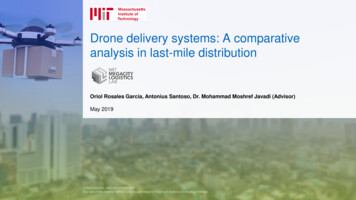
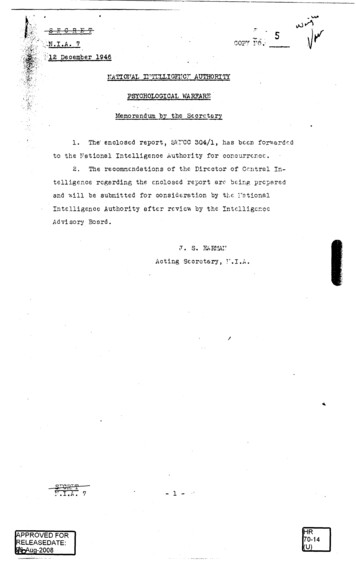
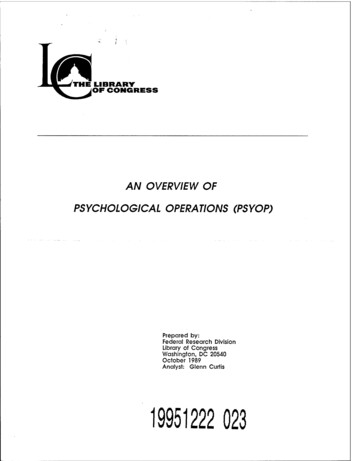

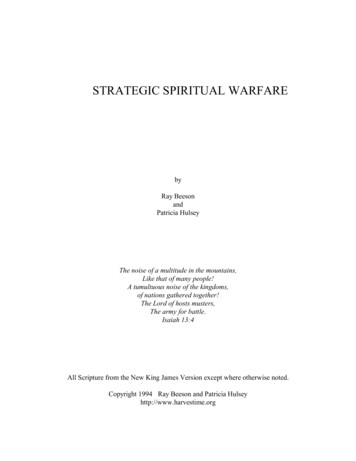
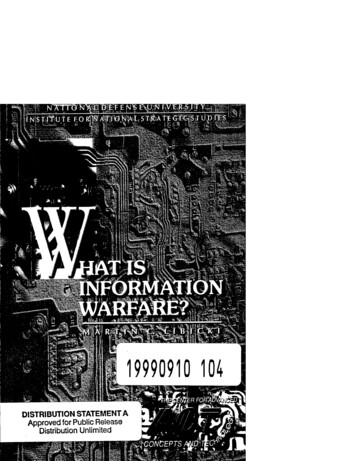
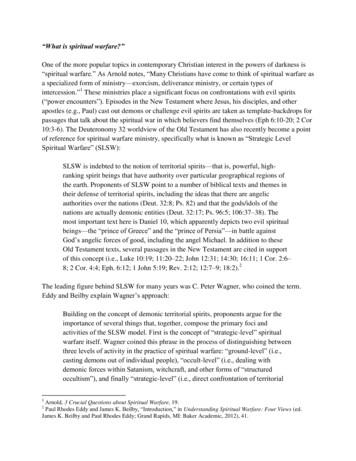


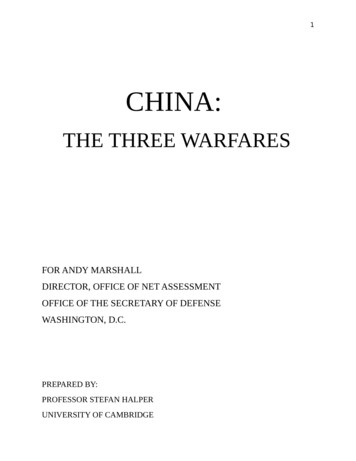
![SECRET SOCIETIES AND PSYCHOLOGICAL WARFARE [1992]](/img/22/1michael-20a-20hoffman-20ii-20-20secret-20societies-20and-20psychological-20warfare.jpg)